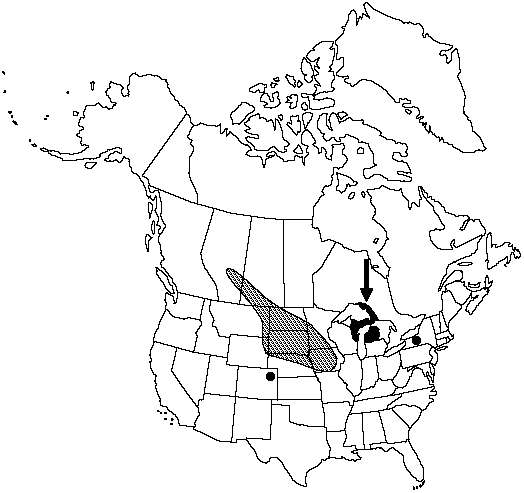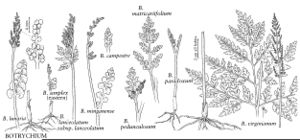Botrychium campestre
Amer. Fern J. 76: 39, figs. 2, 4, 5. 1986.
Trophophore stalk usually absent but sometimes broadly tapered to 10 mm in forms with coalesced proximal pinnae; blade glaucescent, oblong, longitudinally folded when alive, 1-pinnate, to 4 × 1.3 cm, very fleshy. Pinnae to 5 (–9) pairs, spreading, usually remote, separated 1–3 times pinna width, in some populations irregularly and extensively fused with considerable webbing along rachis, distance between 1st and 2d pinnae not or slightly more than between 2d and 3d pairs, basal pinna pair approximately equal in size and cutting to the adjacent pair, mostly linear to linear-spatulate, undivided to tip, margins crenulate to dentate, usually notched or cleft into 2 or several segments, apex rounded to acute, venation like ribs of fan, midrib absent. Sporophores 1 (–2, rarely) -pinnate, 1–1.5 times length of trophophore. 2n =90.
Phenology: Leaves appearing in early spring and dying in late spring and early summer, long before those of associated moonworts.
Habitat: Extremely inconspicuous in prairies, dunes, grassy railroad sidings, and fields over limestone
Elevation: 50–1200 m
Distribution

Alta., Ont., Sask., Colo., Iowa, Mich., Minn., Mont., Nebr., N.Y., N.Dak., S.Dak., Wis., Wyo.
Discussion
Botrychium campestre is one of four moonwort species that commonly produce dense clusters of minute, spheric gemmae at the root bases. Peculiar forms of B. campestre with coalescent pinnae are found on dunes in the vicinity of Lake Michigan.
Of conservation concern.
Selected References
None.
Lower Taxa
"-3timespinnawidth" is not declared as a valid unit of measurement for this property.
